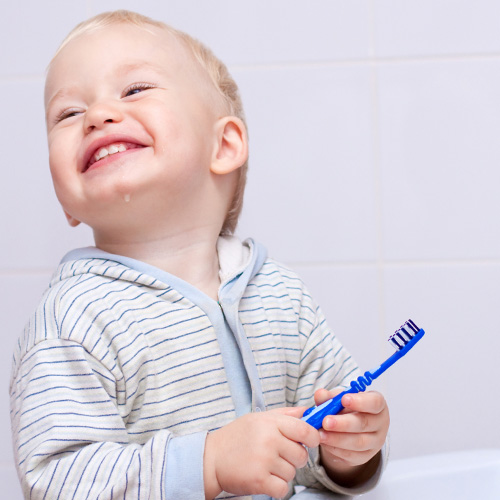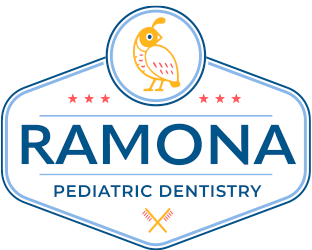Our Pediatric Dentistry Services
Your child’s first visit to the dentist will set the stage for a lifetime of good oral health. As your child grows, regular pediatric dentist visits are just as important as regular visits to the pediatrician. That’s why it’s crucial to find a pediatric dental practice that offers comprehensive care in a soothing, kid-friendly environment.
At Ramona Pediatric Dentistry, our doctors and staff are specially trained in child development and behavior management. We offer an array of services that grow with your children through the years. Our goals are to build lasting relationships with our patients from infancy through college and to instill in them the skills and confidence to maintain a lifetime of excellent oral health.


- Baby Exams
- Fluoride Treatment
- Child Exams
- Dental Sealants
- Digital X-rays
- Space Maintainers
- Dental Cleanings
- Athletic Mouthguards
X-Rays
We practice ALARA (As Low As Reasonably Achievable), a safety principle used to minimize radiation exposure. We are committed to using the most accurate digital imaging equipment with the lowest ionizing radiation exposure. We follow all standard-of-care regulations and guidelines. Click to see Radiation Chart for Dental X-rays.
X-Ray Schedule
Under 3:
Only problem-specific imaging is required.
First visit 3-6:
2 Occlusal Images
(taken only once to see developing permanent teeth on top and bottom front teeth unless problem specific)
2 Bitewing Images
(to evaluate for cavities. Frequency: once per year or every six months, depending on decay risk. If the child has spacing between their back teeth and visual inspection is possible, then cavity check x-rays can be delayed)
Ages 6+:
4 Bitewing Images
(frequency once per year after first permanent molars grow in)
Age 7-8:
Panoramic Image
(taken once at age 7-8, depending on tooth development. This allows us to evaluate the growth and development of adult teeth, check their jaws, and perform orthodontic screening)
Pre-Adolescence:
Full Mouth Image Series
(to perform a comprehensive evaluation of cavities. We may perform this as soon as braces come off)
Age 15:
Panoramic Image
(to evaluate wisdom teeth)
All About Teeth Your Guide To Development & Dentistry
As your child grows, they’ll hit dental milestones.
Here are some things we check for at various stages of your child’s development.
Teething usually starts at 6 months and continues until 2-3 years old. Even if your baby doesn’t have teeth yet, taking care of your child’s gums is still important. Use a soft gauze pad or cloth to gently wipe the baby’s gums after feeding. Avoid transmission of cavity-causing bacteria by limiting behaviors where saliva is shared. This includes sharing utensils or cups with your baby. Along with the ADA and AAPD, we recommend using a “smear” (size of a rice kernel) of fluoridated toothpaste to strengthen and clean the teeth. This very small amount, even if swallowed, is safe for your baby.
It is best to establish feeding times for your child. Babies with frequent contact with formula throughout the day or who are put to sleep with a bottle can develop cavities rapidly. The natural sugar from milk, juice, and even breast milk can cause severe tooth decay if left on the teeth for extended periods. It is recommended to stop using the bottle and sippy cup by age 1 to avoid prolonged exposure to sugars and to help prevent cavities in your children. Ensure your child stops sucking habits (pacifier, thumb, etc) by age 3 if possible to prevent problems with their bite and facial development. It is important to bring your child to the dentist after the first tooth erupts and no later than their first birthday to discuss these topics and check your child’s teeth.
Keep your child’s teeth clean by brushing with a “pea-sized” amount of fluoridated toothpaste 2 times per day. Spit out, but don’t rinse. Brushing before bed is especially important – ensure that the toothbrush is the last thing that touches your child’s teeth before they go to sleep (if possible, avoid eating or drinking after brushing). The contacts between their teeth will become much tighter, so flossing is needed. It’s a good idea to let them brush independently but always brush after them to make sure that their teeth are being properly cleaned. Kids will typically need supervision with brushing until they are at least 8-9 years old.
Around 6 years old, permanent teeth start coming into the mouth starting with the molars. These teeth usually have many deep grooves, and sealants are recommended to avoid cavities in these grooves. Sealants are a white coating that is placed over the grooves of the teeth to prevent plaque and food from getting stuck and causing cavities. Be sure to brush after your kids if you notice the plaque is inadequately brushed away. Emphasize brushing on the chewing surfaces of the back teeth, as well as brushing in small circles around the gumline to remove plaque and prevent cavities and gingivitis. Sometimes, interceptive orthodontics are needed at this age. As your child starts their growth spurt, modifications can be made in their facial growth by appliances or limited orthodontics. During these ages, children become more active with sports, and dental injuries are very common. Mouth guards are recommended during sports or any activities where there is a risk of falls or heavy contact. Ask our team about mouthguards to protect your child’s teeth during sports, especially baseball, basketball, and football.
Kids start gaining independence and making more decisions regarding their diet and nutrition. During their regular dental visits, we will educate your child on these decisions for their dental health and overall health. Sodas, sports drinks, energy drinks, and junk food are consumed by many teens, so we encourage healthier options. By this age, kids most likely have all their permanent teeth, so we will demonstrate proper oral hygiene to them. Evaluations for orthodontics and wisdom teeth are completed at this period, and referrals are given if needed.
Congratulations! If you are pregnant or are planning to become pregnant, your oral health is important to you and your baby. Research shows that bacteria that can cause cavities and gum disease in a mother’s mouth can easily be passed to the child. Studies even show a link between gum disease in mothers and premature, underweight babies. You can and should continue to see your dentist to receive dental exams, cleanings, any necessary X-rays, and treatments. Be sure to inform your dentist if you are pregnant so that they can take the proper precautions for you and your baby. If you have a toothache or gum problems, don’t wait! Contact your dentist immediately!
Even natural sugars and “healthy” snacks can cause tooth decay. Sweetened drinks and sticky snacks are especially likely to cause cavities. It is best to avoid or limit sticky snacks such as candy, dried fruits, cookies, crackers, and gummy fruit snacks. Instead, opt for whole fruits and vegetables, cheese, nuts, and yogurt for snacks. Infants should finish their bedtime and nap time bottles before going to bed. They should never be put to sleep with the bottle, as this causes rapid tooth decay in baby teeth. The sippy cup should not have anything besides water in it throughout the day.
Pediatric dentists have unique expertise and extra training to treat children with special needs. We use our specialized training to ease anxiety and make children feel as comfortable as possible at their dental visits. It is important to establish a dental home for optimal oral health and prevention. When making an appointment, please let us know that your child has special needs, as well as any allergies, conditions, medications, or concerns you may have.
- Tooth-colored fillings
- Crowns
- Baby tooth root canals
- Extractions


 Services
Services